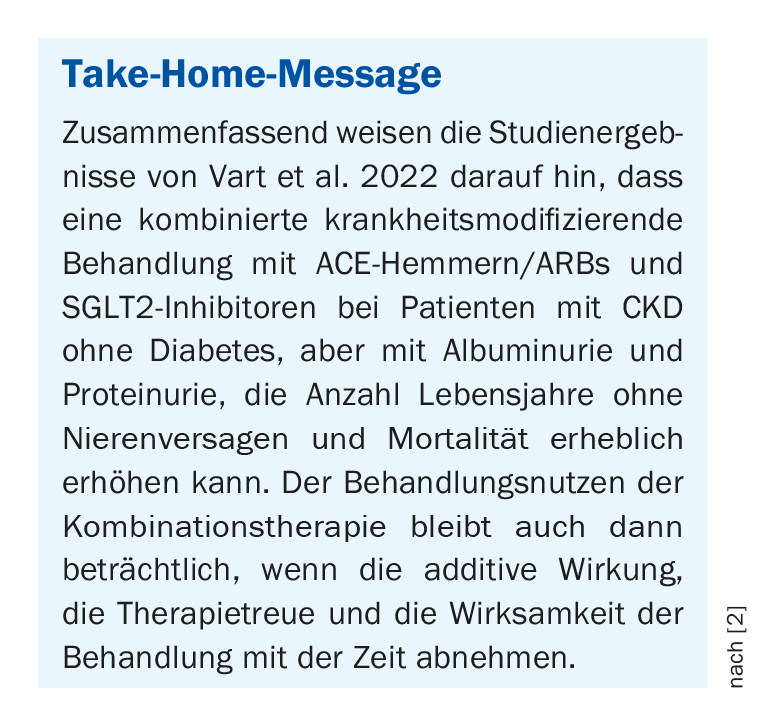The burden of complications of chronic kidney disease (CKD) can be reduced by giving patients RAAS inhibitors combined with SGLT2 inhibitors. This is shown by research recently published in the Clinical Journal of the American Society of Nephrology.
About half of CKD patients do not have diabetes, but have high rates of kidney failure and early death. The first large trial to demonstrate the benefit of SGLT2 inhibitor (SGLT2-i) therapy in patients with impaired renal function with or without diabetes was the DAPA-CKD trial [1]. Based on data from the DAPA-CKD study, Dr. Priya Vart of University Medical Center Groningen (NL) and colleagues performed an analysis to estimate long-term renal failure-free survival in patients with albuminuric CKD without diabetes treated with combination therapy of ACE inhibitors/ARB and SGLT2 inhibitors compared with nontreated patients [2].
Combination of ACE inhibitors/ARB and SGLT2-i
The study used estimates from clinical trials of the effect of treatment with ACE inhibitors/ARB (ramipril/benazepril) (n=690) and SGLT2-i (dapagliflozin, n=1398) compared with placebo to derive the indirect assessment of the effect of combination therapy compared with no treatment [2]. Using this effect, researchers calculated the treatment effect of combination therapy in patients with albuminuric CKD without diabetes in the DAPA-CKD trial (n=697) and predicted renal failure-free and overall survival for patients treated with and without combination therapy. The primary endpoint was a composite of doubling of serum creatinine, renal failure, or death.

Conclusion
Combination therapy with ACE inhibitors/ARB and SGLT2-i was associated with a 65% lower risk for the primary end point than placebo (HR 0.35, 95% confidence interval, 0.30-0.41) [2]. In a 50-year-old patient, the estimated survival was 17.0 years on combination therapy and 9.6 years without treatment with either agent, representing a gain in event-free survival of 7.4 years (95% CI; 6.4-8.7). Even assuming that the effect of combination therapy is not fully additive and that adherence and efficacy may decline over time, there was a gain in event-free survival of 5.3 to 5.8 years. “The present study provides estimates of treatment benefit expressed in terms of additional disease-free years that can be easily understood by patients, clinicians, and policy makers. This could facilitate risk communication in clinical management, increase acceptance of these therapies in clinical practice, and support decision making by policy makers and payers,” the authors write [3].
Literature:
- Heerspink HJL, et al; Investigators D-C: Rationale and protocol of the dapagliflozin and prevention of adverse outcomes in chronic kidney disease (DAPA-CKD) randomized controlled trial. Nephrol DialTransplant 2020; 35: 274-282.
- Vart P, et al: Estimated Lifetime Benefit of Combined RAAS and SGLT2 Inhibitor Therapy in Patients with Albuminuric CKD without Diabetes. CJASN 2022; 17(12): 1754-1762.
- “Lifetime Benefit of Combination Therapy in Patients with Renal Disease Without Diabetes,” https://arznei-news.de/lebenszeitnutzen-einer-kombinationstherapie-bei-patienten-mit-nierenerkrankungen-ohne-diabetes,(last accessed Feb. 13, 2023).
HAUSARZT PRAXIS 2023; 18(2): 40











